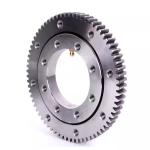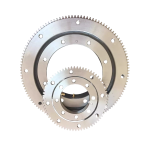Time : septiembre 19, 2024
Slewing Bearing
Slewing bearing is also called turntable bearing, and some people also call it: rotating bearing, slewing bearing.
Introduction
Slewing bearing is a large bearing that can withstand comprehensive loads, and can withstand large axial, radial loads and overturning moments at the same time. Slewing bearings generally have mounting holes, internal or external gears, lubricating oil holes and sealing devices, so that the main machine design structure is compact, easy to guide and easy to maintain. There are four series of slewing bearings: gearless, externally geared and internally geared four-point contact ball bearings, double-row angular contact ball bearings, cross cylindrical roller bearings, cross tapered roller bearings and three-row cylindrical roller composite bearings. Among them, four-point contact ball bearings have higher static load capacity, cross cylindrical rollers have higher dynamic load capacity, and the pre-interference of cross tapered roller bearings can make the bearings have greater support rigidity and rotation accuracy. The three-row cylindrical roller combination bearings are led to the height of the bearing due to the increase in load-bearing capacity. Various forces are borne by different raceways. Therefore, under the same force, the bearing diameter can be greatly reduced, so it has the characteristic of making the host more compact. It is a slewing bearing with high load-bearing capacity. Slewing bearings are widely used in large slewing devices of lifting machinery, mining machinery, construction machinery, port machinery, ship machinery and equipment, as well as high-precision radar machinery and missile launchers. At the same time, various special structure slewing bearings can also be designed, developed and produced according to the specific requirements of users.
Basic Structure
Slewing drive is usually composed of worm, slewing bearing, housing, motor and other components. Since the core components use slewing bearings, they can simultaneously withstand axial force, radial force, and tipping moment. There are many forms, but the structural composition is basically the same.
From left to right (upper part):
1. Outer ring (with or without teeth) 2. Sealing belt 3. Rolling element (ball or roller) 4. Oil nozzle
From left to right (lower part):
1. Blockage 2. Blocking pin 3. Inner ring (with or without teeth) 4. Isolation block or cage 5. Mounting hole (wire hole or light hole)



Application:
Slewing bearings are widely used in real industry and are called “machine joints”. They are mainly used in: automobile cranes, railway cranes, port cranes, marine cranes, metallurgical cranes, container cranes, excavators, filling machines, CT machine standing wave therapy devices, navigation instruments, radar antenna bases, missile launchers, tanks, robots, revolving restaurants, etc.